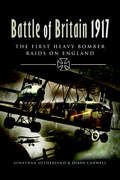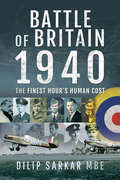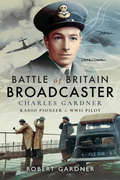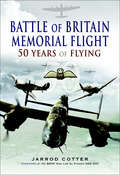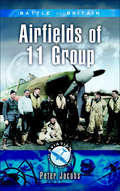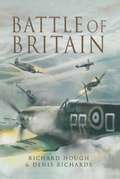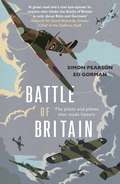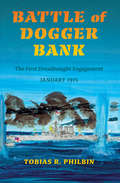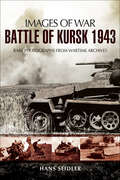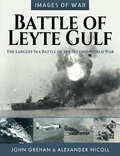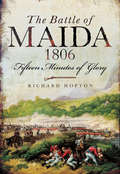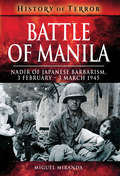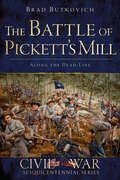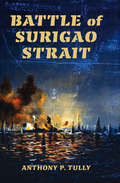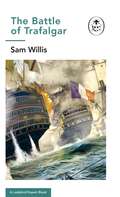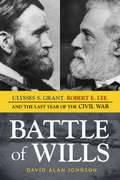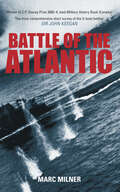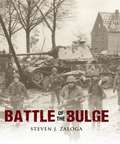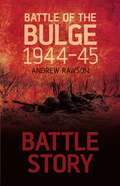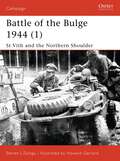- Table View
- List View
Battle of Britain 1917: The First Heavy Bomber Raids on England
by Diane Canwell Jonathan SutherlandIn the autumn of 1916 the Germans began to equip with the Gotha twin-engine bomber. The Gothas were designed to carry out attacks across the channel against Britain. A group of four squadrons was established in Belgium, and they carried out their first bombing raid towards the end of May 1917. This 22 aircraft sortie, against the town of Folkestone, caused 95 deaths. In mid June a force of 18 Gothas attacked London in broad daylight. Over 90 British fighters met them, but not one Gotha was brought down. This bombing raid caused 162 deaths.From mid-September an even larger, more potent bomber joined the Gothas. The Zeppelin-Staaken Riesenflugzeug or "Giant" bomber. It had a range of about 800km (500 miles). The Gotha/Giant night raids continued throughout 1917, almost unscathed until December when the British began to have success in intercepting the Gothas at night. Anti-aircraft fire was also becoming more effective and the increased use of barrage balloons affected the bombers. By the end of the war a 50-mile long line of barrage balloons surrounded London.In the meantime the Giants continued a small but influential campaign against London. On 16 February, during a four aircraft raid, a Giant dropped a 1,000 kg (2,200 lb) bomb—the largest used by anyone in the war—and blew up a wing of the Chelsea hospital.
Battle of Britain 1940: The Finest Hour's Human Cost (Battle Of Britain Ser. #1)
by Dilip Sarkar“Affectingly written . . . a bittersweet memorial to the unheralded casualties of 1940 and their loved ones.” —Michigan War Studies Review The summer of 1940 remains a pivotal moment in modern British history that still inspires immense national pride and a global fascination. The Fall of France was catastrophic. Britain stood alone and within range of German air attack. America, with its vast resources, was neutral, Hitler’s forces unbeaten, the outlook for Britain bleak. As Winston Churchill rightly predicted, “The Battle of Britain is about to begin.” Famously, Churchill mobilized the English language, emboldening the nation with rousing rhetoric. In this darkest of hours, Churchill told the people that this was, in fact, their “Finest Hour,” a time of unprecedented courage and defiance. Connecting the crucial battle with Shakespeare’s heroic Henry V and Agincourt, Churchill also immortalized Fighter Command’s young aircrew as the “Few”—to whom so many owed everything. The Few comprised nearly 3,000 aircrew, 544 of which gave their lives during the Battle of Britain’s sixteen weeks of high drama. Arguably, however, the fighting went on both before and after the official dates of the battle, and many, including civilians, seamen, and ground staff, gave their lives whose names are not included among the Few, a fact not overlooked in this groundbreaking book. In this unique study, veteran historian Dilip Sarkar explores the individual stories of a wide selection of those lost during the “Finest Hour,” examining their all-too-brief lives and sharing their tragic stories, told here in full for the first time. Also included is the story of a German fighter pilot, indicating the breadth of investigation involved. Researched with the full cooperation of the families concerned, this work is a crucial contribution to the Battle of Britain’s bibliography.
Battle of Britain Broadcaster: Charles Gardner, Radio Pioneer & WWII Pilot
by Robert Gardner&“The unique story of a radio broadcasting pioneer and war correspondent, told with affection by his son.&” —Firetrench With the outbreak of World War II, Charles Gardner became one of the first BBC war correspondents and was posted to France to cover the RAF&’s AASF (Advanced Air Strike Force). He made numerous broadcasts interviewing many fighter pilots after engagements with the Germans and recalling stories of raids, bomb attacks and eventually the Blitzkrieg when they all were evacuated from France. In late 1940 he was commissioned in the RAF as a pilot and flew Catalina flying boats of Coastal Command. After support missions over the Atlantic protecting supply convoys from America, his squadron was deployed to Ceylon which was under threat from the Japanese navy. Gardner was later recruited by Lord Mountbatten, to help report the exploits of the British 14th Army in Burma. He both broadcast and filed countless reports of their astonishing bravery in beating the Japanese in jungle conditions and monsoon weather. After the war, Gardner became the BBC air correspondent from 1946-1953. As such, he became known as &“The Voice of the Air,&” witnessing and recording the greatest days in British aviation history. But perhaps he will best be remembered for his 1940 eye-witness account of an air battle over the English Channel when German dive bombers unsuccessfully attacked a British convoy but were driven off by RAF fighters. That broadcast is still played frequently today.
Battle of Britain Memorial Flight: 50 Years of Flying
by Jarrod CotterThe history of the Flight began with the formation of the Historic Aircraft Flight in July 1957, it was later to become known as The Battle of Britain Memorial Flight. Countless displays and fly-pasts have enthralled audiences and enthusiasts all over Britain and in many parts of Europe, when the traditional Avro Lancaster, Spitfire and Hurricane can be seen in their wartime colors and the growl of all six Merlin engines stirs many nostalgic memories.This book is written with the wholehearted support of the Flights Commanding Officer and the author has access to archive material. The book includes a Foreword from the OC BBMF, a complete history of the unit, chapters on each of the types operated, including the DC-3 Dakota and de Havilland Chipmunk and present-day operations. Photos include superb images from the BBMF archives, the authors collection that includes historic black and white shots from the early days, air-to-air color, personalities and behind-the-scenes images.This is the ultimate souvenir of the celebration of the BBMFs 50th Anniversary.
Battle of Britain: Airfields Of 11 Group (Aviation Heritage Trail Ser.)
by Peter JacobsThe Royal Air Force's 11 Group played a leading role in the Battle of Britain. It included the airfields at Tangmere, Westhampnett, Kenley, Croydon, Biggin Hill, West Malling, Horchurch, Hawkinge, Gravesend, Manston, Rochford, North Weald, Martlesham Heath, Stapleford Tawney, Debden and Northolt. The most famous of 'The Few' saw action in this vital airspace over southern England, London and the Home Counties. The book will give an overview of the Battle and then go on to describe the part played by the squadrons and pilots from each base between the dangerous period between 10 July and 31 October 1940. It will include a map of each airfield as it was then and a guide to what remains and places of significance nearby that can be visited today.
Battle of Britain: Day by day Chronicle
by Patrick BishopThe Battle of Britain is the epic story of the fight for control of the skies over England in the bitterly long summer of 1940. Bestselling author Patrick Bishop's compelling day-to-day chronicle is enhanced with eye-witness accounts, diary extracts and pilot profiles, as the horrific reality of air combat is vividly portrayed in this account of the life and death struggle between the Royal Air Force and the Luftwaffe. This is the story Britain's "finest hour," a fight for national survival that had a profound impact on servicemen and civilians alike, and ultimately proved to be a key a turning point in the course of the war.
Battle of Britain: The Greatest Air Battle Of World War Ii
by Richard Hough Denis RichardsThe Battle of Britain was one of the crucial conflicts in the history of civilisation. It started officially on 10 July 1940 and ended on 31 October 1940. Hitlers plans for the invasion of England were thwarted by two types of fighter aircraft, the Spitfire and Hurricane, and a relative handful of young pilots, The Few.This fine book tells the momentous story of this unequal struggle, from the key events leading up to it, by graphic day-by-day accounts recording the action and commentary on the strategy. The authors personal knowledge of key figures means that there are many thrilling first-hand accounts by the aces, such as Peter Townsend, Bob Standford Tuck, Douglas Bader, Richard Hillary, Sailor Malan and other great men.This well-rounded book covers the contributions of Fighter Commands three Groups (10, 11 and 12) as well as the key roles played by RAF and WAAF groundstaff without whose tireless efforts the Battle would have been lost. A superb book which is unlikely to be bettered in its class.
Battle of Britain: The pilots and planes that made history
by Ed Gorman Simon Pearson'A useful contribution to an overcrowded field of history by giving deserved attention to the ordinary men and unsung machines that aren't usually included in the dramatic narrative.' - The Times'A great read and a real eye-opener to anyone who thinks the Battle of Britain is only about Brits and Germans and Messerschmitts and Spitfires. The value in this account is also the way the back stories of many previously unheralded pilots come to life.' - General Sir David Richards, former Chief of the Defence Staff***In Battle of Britain: The pilots and planes that made history, Ed Gorman and Simon Pearson paint a vivid picture of the men and their machines as the battle for air superiority over Britain is played out across the skies of Europe, from the west of Ireland to the German capital.We experience the battle chronologically through the remarkable stories of eighteen airmen from across the world. Some will be new to many readers: the New Zealander who "borrowed" a seaplane from the Royal Navy to set up a freelance air-sea rescue service that saved the lives of dozens of British and German pilots; the Swiss baron who claimed to have destroyed six British fighters in a day; the vainglorious commander whose RAF squadron was wiped out trying to disrupt Nazi invasion plans; and the German bomber pilot who fought the first battle involving foreign troops on British soil since Culloden - before repairing to a pub for a pint with soldiers who had taken him prisoner.Illustrated with contemporary photographs of the pilots and their aircraft, this is an enthralling and original account from both sides of a conflict that shaped the modern world, full of courage, endeavour and, above all, humanity.
Battle of Britain: The pilots and planes that made history
by Ed Gorman Simon PearsonAn original, 360-degree re-telling of the Battle of Britain through 18 of the iconic (and some less well-known) aircraft and the pilots who flew them - British, Polish, New Zealander, German, Danish.In Battle of Britain: The Pilots and the Planes That Made History, Ed Gorman and Simon Pearson paint a vivid picture of the men and their machines as the battle for air superiority over Britain is played out across the skies of Europe, from western Ireland to the German capital.They tell remarkable stories involving hitherto unknown airmen from across the world who flew aircraft, including some that will be new to many readers: the New Zealander who "borrowed" a seaplane from the Royal Navy to set up a freelance air-sea rescue service that saved the lives of dozens of British and German pilots; the Swiss baron who destroyed nine British fighters in a day; the vainglorious Dane whose RAF squadron was wiped out trying to disrupt Nazi invasion plans; and the German bomber pilot who fought the last battle involving foreign troops on British soil since Culloden - before repairing to a pub in Kent for a pint with soldiers from the Irish Rifle, who had taken him prisoner.These are enthralling stories from both sides of a conflict that shaped the modern world, full of courage, endeavour and above all, humanity.(P) 2020 Hodder & Stoughton Ltd
Battle of Dogger Bank: The First Dreadnought Engagement, January 1915 (Twentieth-Century Battles)
by Tobias R. PhilbinThe definitive study of one of the pivotal naval battles of the Great War. On January 24, 1915, a German naval force commanded by Admiral Franz von Hipper conducted a raid on British fishing fleets in the area of the Dogger Banks. The force was engaged by a British force, which had been alerted by a decoded radio intercept. The ensuing battle would prove to be the largest and longest surface engagement until the Battle of Jutland the following summer. While the Germans lost an armored cruiser with heavy loss of life and Hipper&’s flagship was almost sunk, confusion in executing orders allowed the Germans to escape. The British considered the battle a victory; but the Germans had learned important lessons and they would be better prepared for the next encounter with the British fleet at Jutand. Tobias Philbin&’s Battle of Dogger Bank provides a keen analytical description of the battle and its place in the naval history of World War I. &“Tobias Philbin has written a very entertaining and informative book on the Battle of Dogger Bank. It will be enjoyed by a wide audience including naval historians, strategists, and those interested in how broader long-term decision-making determines the manner in which battles are fought, won and lost.&” —The International Journal of Maritime History &“The author&’s research in British and German archives and knowledge of secondary sources produces a significant work on the war at sea.&” —Stand-To &“An interesting and stimulating book that is a useful contribution to the history of the First World War in the North Sea.&” —The Mariner&’s Mirror
Battle of Kursk, 1943 (Images of War)
by Hans Seidler"The greatest tank battle in world history, known as Operation CITADEL, opened during the early hours of 5 July 1943, and its outcome was to decide the eventual outcome of the war on the Eastern Front. Images of War—Battle of Kursk 1943, is an illustrated account of this pivotal battle of the war on the Eastern Front, when the Germans threw 900,000 men and 2,500 tanks against 1,300,000 soldiers and 3,000 tanks of the Red Army in a savage battle of attrition.Unlike many pictorial accounts of the war on the Eastern Front, Battle of Kursk 1943 draws upon both German and Russian archive material, all of which are rare or unpublished. The images convey the true scale, intensity and horror of the fighting at Kursk, as the Germans tried in vain to batter their way through the Soviet defensive systems. The battle climaxed at the village of Prokhorovka, which involved some 1,000 tanks fighting each other at pointblank range.During this vicious two week battle the Red Army dealt the Panzerwaffe a severe battering from which the German war effort was never to recover fully. Kursk finally ended the myth of German invincibility."
Battle of Leyte Gulf: The Largest Sea Battle of the Second World War (Images of War)
by John Grehan Alexander NicollA photographic history of World War II’s largest naval battle, in which the Japanese and Americans squared off in the Philippines.On October 20, 1944, the U.S. Sixth Army began landing on Leyte’s eastern coast, supported by the U.S. Navy's 3rd and 7th fleets, which were assisted by ships from the Royal Australian Navy. The Japanese were aware that the Americans were poised to attack the Philippines and planned to draw the American warships into one last great battle to try and stave off the otherwise inevitable defeat. Over the course of the following three days, the two naval forces had four separate engagements. Involving more than 360 ships and 200,000 naval personnel, the battle was the greatest naval encounter of World War II—and possibly the largest naval battle in history.The result was disastrous for the Japanese, who lost three battleships, four aircraft carriers, ten cruisers, and eleven destroyers, along with almost 300 aircraft—the greatest loss of ships and crew the Japanese had ever experienced. In Battle of Leyte Gulf, the actions of the warships as well as the accompanying amphibious landings on Leyte by the U.S. Sixth Army are vividly revealed through a dramatic collection of photographs depicting the ships, sailors, airmen, and soldiers who made history.
Battle of Maida, 1806: Fifteen Minutes Of Glory
by Richard HoptonA nation's history is littered with conveniently forgotten defeats and military disasters but it is unusual for significant victories to be ignored. Richard Hopton, the up-and-coming historian, has uncovered the long overlooked defeat of Napoleon's forces by General Sir John Stuart at Maida, Southern Italy in 1806. For many years the only hint that there had been a triumph there has been the residential area of North West London that derives its name from the battle. Following UIm and Austerlitz, Napoleon's reputation for military genius was fast becoming a morale problem for his opponents, in the same way that Rommel's prowess did some 240 years later. No small part of the significance of the Allied victory at Maida in 1806 was the proof it offered that the French under Napoleon were not invincible. The author brilliantly describes the cast of colorful yet highly improbable characters whom fate and circumstances brought together. Arguably pride of place must go to Ferdinand II, Ruler of the Kingdom of the Two Sicilies, whose eccentricity was only exceeded by his abject incompetence.
Battle of Manila: Nadir of Japanese Barbarism, 3 February–3 March 1945 (History of Terror)
by Miguel MirandaThis &“extensively researched and well-illustrated&” history recounts the bloody fight to liberate Manila from occupation during WWII (WWII History Magazine). For nearly four years during the Second World War, Japanese occupation had devastated the Philippines. Then, in 1944, General MacArthur led a massive army of American and Filipino forces determined to take back the island nation. Essential to the Philippine Campaign was recapturing the country&’s once-glittering capital city, Manila. In late January of 1945, the Allied forces embarked on the necessary and urgent mission. Trapped within the old University of Santo Tomas were thousands of ailing prisoners at risk of torture and death by their captors. As the desperate Japanese navy fought to keep the advancing Americans at bay, Japanese troops began killing civilians caught in the crossfire—or using them as human shields. Thousands of Filipinos were trapped in what became the most bitter combat seen in the Pacific Theater.
Battle of Peleliu, 1944: Three Days That Turned into Three Months (Images Of War Ser.)
by Jim MoranAfter the Allies had defeated the Japanese in the Solomons and the Dutch East Indies, the capture of the Philippines became General MacArthur’s next objective. For this offensive to succeed, MacArthur felt compelled to secure his eastern flank by seizing control of the Palau Islands, one of which was Peleliu. The task of capturing this island, and the enemy airfield on it, was initially handed to Admiral Nimitz. The Palau Islands, however, formed part of Japan’s second defensive line, and Peleliu’s garrison amounted to more than 10,000 men. Consequently, when the US preliminary bombardment began on 12 September 1944, it was devastating. For two days the island was pounded relentlessly. Such was the scale of the destruction that the commander of the 1st Marine Division, Major General William H. Rupertus, told his men: ‘We’re going to have some casualties, but let me assure you this is going to be a fast one, rough but fast. We’ll be through in three days – it may only take two.’ At 08.32 hours on 15 September 1944, the Marines went ashore. Despite bitter fighting, and a ferocious Japanese defence, by the end of the day the Marines had a firm hold on Peleliu. But rather than Japanese resistance crumbling during the following days as had been expected, it stiffened, as they withdrew to their prepared defensive positions. The woods, swamps, caves and mountains inland had been turned into a veritable fortress – it was there where the real battle for possession of Peleliu was fought. Day after day the Americans battled forward, gradually wresting control of Peleliu from the Japanese. Despite Major General Rupertus’ prediction, it was not until 27 November, after two months, one week and five days of appalling fighting, and a final, futile last sacrificial charge by the remaining enemy troops, that the Battle of Peleliu came to an end.
Battle of Pickett's Mill: Along The Dead Line (Civil War Series)
by Brad ButkovichThis Civil War history examines one of General Sherman devastating losses—a battle famously captured in Ambrose Bierce&’s The Crime at Pickett&’s Mill. On May 27, 1864, Union forces under the command of William Tecumseh Sherman attacked Confederate general Joseph E. Johnston and his men at Pickett&’s Mill in Paulding County, Georgia. Following his defeat at New Hope Church, Sherman ordered Major General Oliver Howard to attack Johnston's flank, which Sherman believed to be exposed. But the Confederate soldiers were ready, and Sherman's supporting troops never arrived. What ensued was a battle that cost 2,100 lives and a defeat that Sherman left completely out of his memoirs. In this detailed historical analysis, Brad Butkovich draws on personal letters, newspaper accounts and unit histories to bring to life the battle that Union soldier and author Ambrose Bierce called &“the Dead-Line.&”
Battle of Roanoke Island, The: Burnside and the Fight for North Carolina (Civil War Series)
by Michael P. ZatargaIn the winter of 1861, Union armies had failed to win any significant victories over their Confederate counterparts. The Northern populace, overwhelmed by the bloodshed, questioned whether the costs of the war were too high. President Lincoln despondently wondered if he was going to lose the Union. As a result, tension was incredibly high when Union hero Ambrose Burnside embarked for coastal North Carolina. With the eyes of the nation and world on little Roanoke Island in the Outer Banks, Burnside began his amphibious assault on the beaches and earned a victory that shifted control of Southern waters. Join author and historian Michael Zatarga as he traces the story of the crucial fight on Roanoke Island.
Battle of Surigao Strait (Twentieth-Century Battles)
by Anthony P. Tully&“[Tully] paints Admiral Nishimura's high-speed run into history with an entirely fresh palette of detail.&” —James D. Hornfischer, New York Times–bestselling author of Neptune&’s Inferno Surigao Strait in the Philippine Islands was the scene of a major battleship duel during the Battle of Leyte Gulf. Because the battle was fought at night and had few survivors on the Japanese side, the events of that naval engagement have been passed down in garbled accounts. Anthony P. Tully pulls together all of the existing documentary material, including newly discovered accounts and a careful analysis of US Navy action reports, to create a new and more detailed description of the action. In several respects, Tully's narrative differs radically from the received versions and represents an important historical corrective. Also included in the book are a number of previously unpublished photographs and charts that bring a fresh perspective to the battle. &“By giving a fuller view of the Japanese side, Tully's work forces a substantial revision of the traditional picture of the battle. Battle of Surigao Strait is not only military history based on scrupulous use of a plethora of new source materials, but is a spanking good read. Highly recommended.&” —War in History &“Tully has managed to trace the complicated flow of and reason for events on the nights of 24-25 October with a skill and aplomb that forces one to reconsider previously held views.&” —Naval History
Battle of Trafalgar: A Ladybird Expert Book (The Ladybird Expert Series #28)
by Sam WillisPart of the ALL-NEW LADYBIRD EXPERT SERIES'Packs plenty of heft into its slender page count' HISTORY REVEALED- Why was the Battle of Trafalgar such an important British victory in the Napoleonic Wars? - How did the British fleet show their strength against the French and Spanish? - How did Nelson excel in his final battle?FOLLOW the daring strategy and brilliant leadership of Horatio Nelson in Britain's stunning triumph against Napoleon's forces. From the might of Britain's war machine to the death of the world's most impressive naval commander, discover why Trafalgar remains the most famous naval battle in history.BRITAIN'S GLORIOUS VICTORY, AND NELSON'S FINAL BATTLEWritten by historian, archaeologist, and broadcaster Sam Willis, The Battle of Trafalgar is a gripping and accessible introduction to the battle that established Britain as a formidable seapower for many years to come.
Battle of Wills: Ulysses S. Grant, Robert E. Lee, and the Last Year of the Civil War
by David Alan JohnsonHistorians have long analyzed the battles and the military strategies that brought the American Civil War to an end. Going beyond tactics and troop maneuvers, this book concentrates on the characters of the two opposing generals--Robert E. Lee and Ulysses S. Grant--showing how their different temperaments ultimately determined the course of the war. As author David Alan Johnson explains, Grant's dogged and fearless determination eventually gained the upper hand over Lee's arguably superior military brilliance. Delving into their separate upbringings, the book depicts Grant as a working-class man from Ohio and Lee as a Virginia aristocrat. Both men were strongly influenced by their fathers. Grant learned a lesson in determination as he watched his father overcome economic hardships to make a successful living as a tanner and leather goods dealer. By contrast, Lee did his best to become the polar opposite of his father, a man whose bankruptcy and imprisonment for unpaid debts brought disgrace upon the family. Lee cultivated a manner of unimpeachable respectability and patrician courtesy, which in the field of battle did not always translate into decisive orders. Underscoring the tragedy of this fratricidal conflict, the author recounts episodes from the earlier Mexican war (1846-1848), when Grant and Lee and many other officers who would later oppose each other were comrades in arms. This vivid narrative brings to life a crucial turning point in American history, showing how character and circumstances combined to have a decisive influence on the course of events.From the Hardcover edition.
Battle of the Atlantic
by Marc MilnerWorld War II was only a few hours old when the Battle of the Atlantic, the longest campaign of the Second World War and the most complex submarine war in history, began with the sinking of the unarmed passenger liner Athenia by the German submarine U30. Based on the mastery of the latest research and written from a mid-Atlantic - rather than the traditional Anglo-centric - perspective, Marc Milner focuses on the confrontation between opposing forces and the attacks on Allied shipping that lay at the heart of the six-year struggle. Against the backdrop of the battle for the Atlantic lifeline he charts the fascinating development of U-boats and the techniques used by the Allies to suppress and destroy these stealth weapons.
Battle of the Atlantic: Gauntlet to Victory
by Ted BarrisThe Battle of the Atlantic, Canada’s longest continuous military engagement of the Second World War, lasted 2,074 days, claiming the lives of more than 4,000 men and women in the Royal Canadian Navy, the Royal Canadian Air Force and the Canadian merchant navy The years 2019 to 2025 mark the eightieth anniversary of the longest battle of the Second World War, the Battle of the Atlantic. It also proved to be the war’s most critical and dramatic battle of attrition. For five and a half years, German surface warships and submarines attempted to destroy Allied trans-Atlantic convoys, most of which were escorted by Royal Canadian destroyers and corvettes, as well as aircraft of the Royal Canadian Air Force. Throwing deadly U-boat “wolf packs” in the paths of the convoys, the German Kriegsmarine almost succeeded in cutting off this vital lifeline to a beleaguered Great Britain.In 1939, the Royal Canadian Navy went to war with exactly thirteen warships and about 3,500 regular servicemen and reservists. During the desperate days and nights of the Battle of the Atlantic, the RCN grew to 400 fighting ships and over 100,000 men and women in uniform. By V-E Day in 1945, it had become the fourth largest navy in the world. The story of Canada’s naval awakening from the dark, bloody winters of 1939–1942, to be “ready, aye, ready” to challenge the U-boats and drive them to defeat, is a Canadian wartime saga for the ages. While Canadians think of the Great War battle of Vimy Ridge as the country’s coming of age, it was the Battle of the Atlantic that proved Canada’s gauntlet to victory and a nation-building milestone.
Battle of the Bulge
by Steven J. ZalogaThe Battle of the Bulge was the last major German offensive in the West and the largest and the most costly battle fought by the US Army in World War II. Fought during the bitter winter of 1944-45, and resulting in over 100,000 German casualties and over 80,000 American casualties, it turned an apparent defeat into what British Prime Minister Winston Churchill called 'an ever-famous American victory'. Three armies attacked through the Ardennes, the weakest point in the American lines - and almost broke through. At St Vith and Elsenborn Ridge, Hitler, gambling everything in the hope that the residual might of the German army would not only force a breakthrough but would also split the Allied coalition in two, concentrated the bulk of his Panzer forces in the form of the Sixth Panzer Army. When the German advance here failed, Hitler switched the focus of the offensive to General Manteuffel's 5th Panzer Army in the south. Heavily attacked by superior German armor, outnumbered and without air support, the US army was on its own. The green US 106th Division held its own for a time, but then gave way in the biggest US surrender since Kasserine. German Panzers flooded towards the River Meuse. But at Bastogne their way was barred by the paratroopers of the 101st Airborne, the "Screaming Eagles". The ensuing battle of Bastogne would prove to be one of the most decisive battles of the war. In spite of its ultimate German failure, the Battle of the Bulge would have an important effect on the War and its aftermath: it slowed the Allies down, resulting in more territory being ceded to the Russian sphere of influence at the end of the War. This book on the decisive campaign of the war in northwest Europe provides a full account of the campaign strategy; the American and German forces and command; their equipment and tanks; and a detailed account of the fighting.
Battle of the Bulge 1944-45
by Andrew RawsonIn December 1944 the German military made its final attempt to end the Second World War by throwing in all its reserves in a desperate attempt to shatter the Allied lines. After breaking through the American-held sector in the Ardennes, two Panzer armies headed for the bridges over the River Meuse. However, a combination of poor planning, bad weather, tortuous terrain and, above all, the determined defence of keys towns and villages delayed the advance. The Allies were able to hold the northern and southern shoulders of the attack, hemming the Germans in. The Bulge had been created, and as the fortunes of battle were reversed, the Allies struck back.In Battle of the Bulge 1944–45, historian Andrew Rawson gives a clear, concise account of those dramatic days at the end of 1944, supported by a timeline of events and orders of battle. If you want to understand what happened and why – read on.
Battle of the Bulge 1944: 115
by Steven Zaloga Howard GerrardOsprey's first title examining the Battle of the Bulge, which was the largest and most costly battle fought by the US Army in World War II (1939-1945). The Ardennes fighting was Hitler's last gamble on the Western Front, crippling the Wehrmacht for the remainder of the war. In the first of two volumes on the Ardennes campaign Steven Zaloga details the fighting in the northern sector around St Vith and the Elsenborn Ridge. Sixth Panzer Army, containing the bulk of German Panzer strength, was expected to achieve the breakthrough here. It was the failure around St Vith that forced the Germans to look south towards Bastogne.
